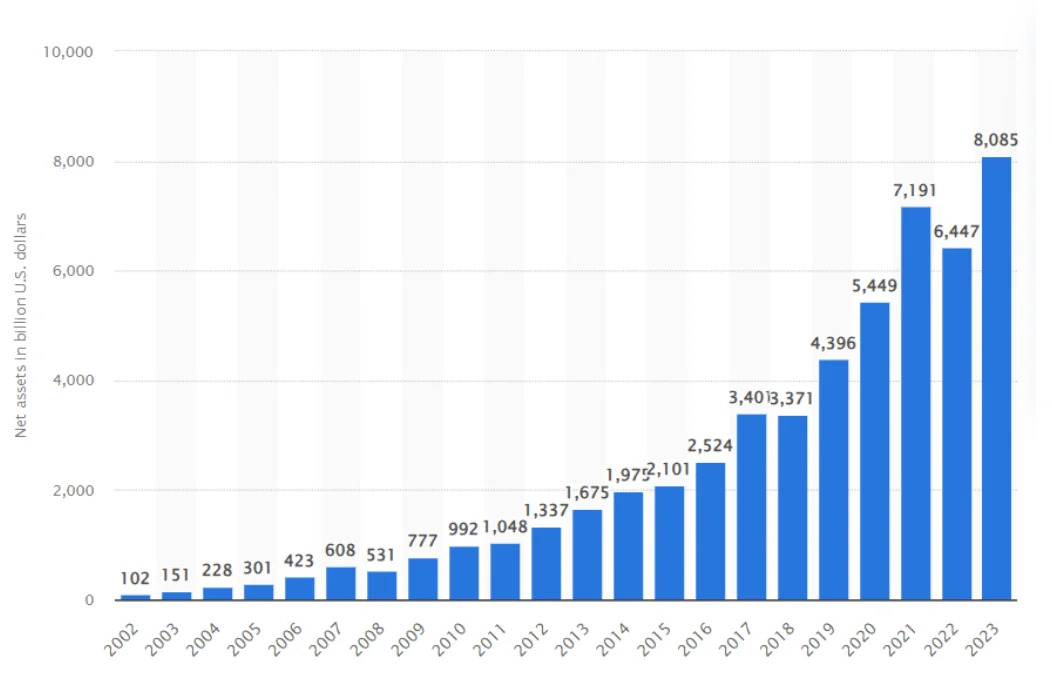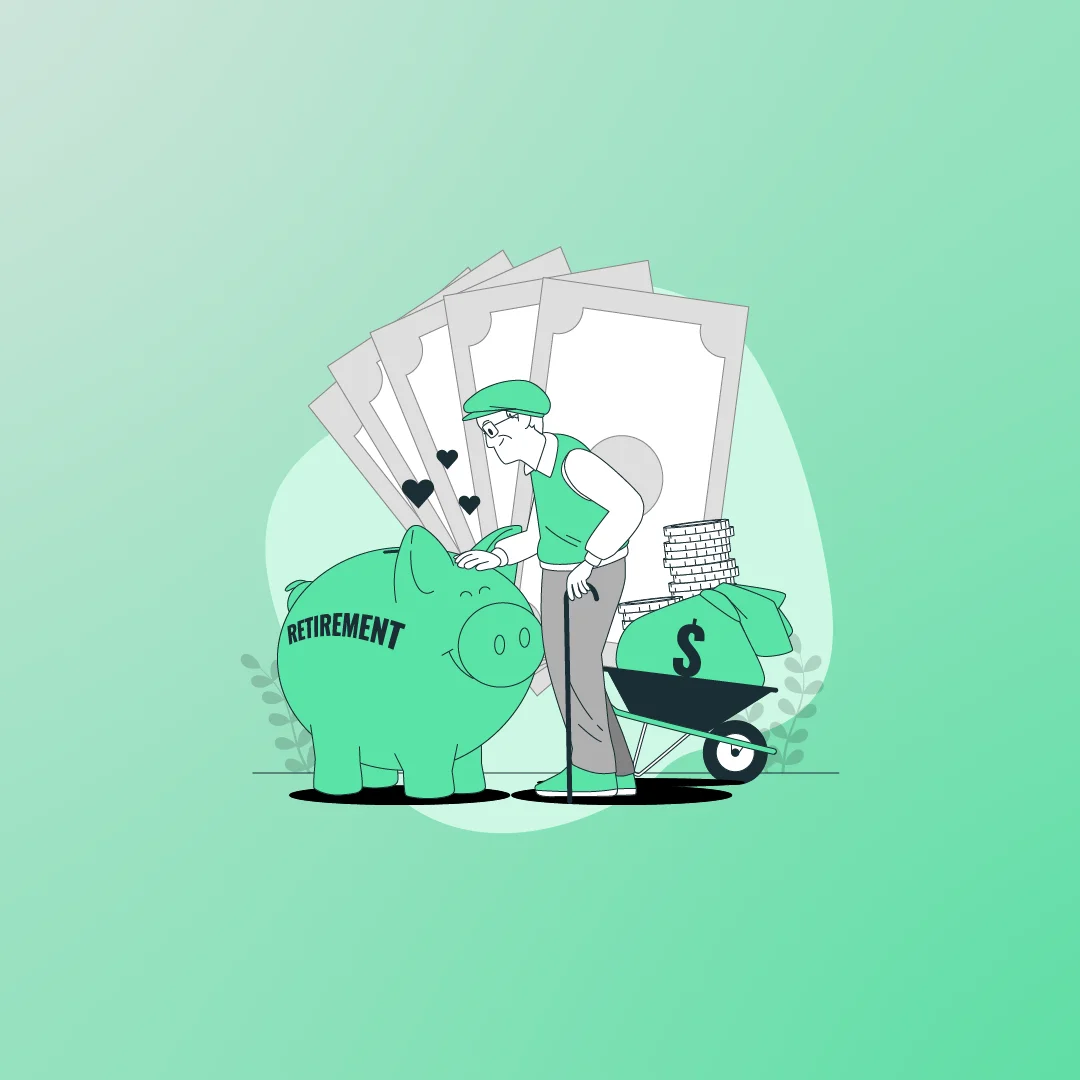Stocks vs. ETFs: Which is the Best Investment for You?

Dany M.

Investing in the stock market has long been a popular way to grow wealth, but in recent years, exchange-traded funds (ETFs) have emerged as an attractive option. In fact, as of 2024, ETF assets reached a new record high of $12.89 trillion globally. In the U.S. alone, ETFs account for about $8.09 trillion.

(Total net assets of ETFs in the United States 2002-2023, Source: Statista)
Both stocks and ETFs have opportunities for financial growth, but they're structured differently, have different risk profiles, and are managed differently.
Learning the main differences between stocks and ETFs and knowing when to pick stocks over ETFs (or vice versa) can have a big effect on how well your investments do. Let’s take a look at each option.
Stocks vs ETFs: What Are They?

Stocks and ETFs are two popular investment vehicles, but they have distinct characteristics that set them apart.
Stocks
Stocks represent ownership in a single company. When you buy a share of stock, you're purchasing a small piece of that company's assets and earnings. For example, if you own 100 shares of Apple, you own a tiny fraction of the tech giant.
ETFs
An ETF is a type of investment fund that holds a collection of securities such as stocks, bonds, or commodities. ETFs are designed to track the performance of a specific index, sector, or asset class. Unlike stocks, when you buy an ETF, you're investing in a collection of assets rather than a single company.
ETFs come in various types, including:
Stock ETFs track a stock index like the S&P 500
Bond ETFs invest in various types of bonds
Sector ETFs focus on specific industries like technology or healthcare
Commodity ETFs track the price of commodities like gold or oil
Both stocks and ETFs are traded on exchanges, allowing investors to buy and sell them throughout the trading day at market-determined prices.
Stocks vs ETFs: How Do They Differ in Ownership and Structure?
Stock Ownership
When you buy a stock, you become a direct partial owner of the company. This ownership comes with certain rights, such as:
Voting rights at shareholder meetings
Potential to receive dividends if the company declares them
Claim on the company's assets in case of liquidation (after creditors are paid)
The number of shares you own determines your level of ownership and voting power. Stocks are issued by companies during initial public offerings (IPOs) or secondary offerings.
ETF Ownership
ETFs use a unique "creation/redemption" process involving authorized participants (APs) to create or redeem ETF shares in large blocks. With ETFs, the ownership structure is more complex:
You own shares of the ETF, not the underlying assets directly
The ETF provider owns the underlying assets
Your ownership is proportional to the number of ETF shares you hold
ETFs have a dual trading mechanism, on the exchange like stocks, and through the creation/redemption process.
Here's how the ownership structures compare:
Stocks | ETFs |
Direct ownership in a company | Indirect ownership of multiple assets |
Voting rights in company decisions | No direct voting rights in underlying companies |
Potential for individual dividend payments | Distributions based on fund performance |
Stocks vs ETFs: Which Has More Risk and Volatility?
Individual stocks generally carry more of both compared to ETFs. This difference stems from the fundamental nature of these investment vehicles.
Individual stocks represent ownership in a single company, which means their performance is tied directly to that company's fortunes. If the company faces challenges or the market reacts negatively to its news, the stock price can fluctuate dramatically.
ETFs, on the other hand, typically hold a basket of securities, which provides built-in diversification. This diversification helps to spread risk across multiple companies or assets, potentially reducing the impact of poor performance from any single holding.
Here's a comparison of volatility measures:
Measure | Individual Stocks | ETFs |
Average Daily Price Change | Can exceed 5% | Typically less than 1% for broad market ETFs |
Beta (market sensitivity) | Can range from negative to over 2 | Often close to 1 for market-cap weighted ETFs |
Sharpe Ratio (risk-adjusted return) | Varies widely | Generally higher due to diversification |
It's important to note that not all ETFs are created equal in terms of risk and volatility. Sector-specific or thematic ETFs can be more volatile than broad-market ETFs.
Investors should also be aware of the concept of "black swan" events – rare, unpredictable occurrences that can have severe consequences. While these events can affect both stocks and ETFs, individual stocks are more vulnerable to company-specific black swans, such as accounting scandals or sudden leadership changes.
Stocks vs ETFs: What Are the Costs and Fees?
When it comes to investing, costs and fees can significantly impact your returns over time. Both stocks and ETFs come with their own set of expenses, but they differ in structure and amount.
Stock Costs
Trading Commissions: Many brokers now offer commission-free stock trading, but some may charge $0 to $6.95 per trade.
Bid-Ask Spread: The difference between the buying and selling price, which can be wider for less liquid stocks.
Account Maintenance Fees: Some brokers charge annual fees, typically ranging from $0 to $75.
ETF Costs
Expense Ratio: This is the primary cost for ETFs, representing the annual fee charged by the fund.
Trading Commissions: Like stocks, many ETFs now trade commission-free.
Bid-Ask Spread: Generally tighter than individual stocks, especially for popular ETFs.
Here's a comparison of average costs:
Cost Type | Stocks | ETFs |
Annual Fees | $0 - $75 | 0.16% of assets (avg.) |
Trading Commissions | $0 - $6.95 per trade | Often $0 |
Bid-Ask Spread | Varies widely | Generally tighter |
It's important to note that while ETFs have ongoing expenses (expense ratios), they often provide built-in diversification, which could be costly to achieve with individual stocks. For example, to replicate the S&P 500 index with individual stocks, you'd need to make 500 separate purchases, potentially incurring significant transaction costs.
The impact of these costs can be substantial over time. For instance, on a $10,000 investment growing at 7% annually for 30 years:
With a 0.03% fee (low-cost ETF), You'd have about $75,600
With a 0.50% fee (higher-cost ETF or frequent stock trading), You'd have about $68,000
That's a difference of $7,600 due to fees alone.
Investors should also be aware of potential hidden costs. For stocks, these might include reorganization fees for corporate actions. For ETFs, watch out for funds with high turnover rates, which can lead to higher transaction costs within the fund and potentially higher capital gains distributions.
Stocks vs ETFs: Which Offers Better Liquidity and Trading Flexibility?
Liquidity and trading flexibility can have a big effect on an investor's ability to make trades quickly and at good prices. Both stocks and ETFs offer unique characteristics in these areas.
When it comes to liquidity, individual stocks can vary widely. Blue-chip stocks like Apple (AAPL) or Microsoft (MSFT) typically boast high liquidity, with millions of shares changing hands daily. Because of this high trading volume, investors can buy or sell a lot of shares without the market price changing much.
Smaller or less popular stocks, on the other hand, may not be as liquid, which could mean wider bid-ask spreads and bigger price changes when trading.
ETFs, on the other hand, generally offer consistent liquidity across the board, thanks to their unique structure. The creation and redemption process allows authorized participants to create new ETF shares or redeem existing ones in response to supply and demand. This mechanism helps keep ETF prices closely aligned with their underlying net asset value (NAV) and provides an additional layer of liquidity beyond what's available on the exchange.
Trading Flexibility
Both stocks and ETFs offer similar trading options, but with some key differences:
Feature | Stocks | ETFs |
Intraday Trading | Yes | Yes |
Order Types | Market, Limit, Stop-loss | Market, Limit, Stop-loss |
Fractional Shares | Available with some brokers | Available with some brokers |
Short Selling | Yes | Yes |
Options Trading | Available for many stocks | Available for many ETFs |
One of the best things about trading ETFs is that you can get exposure to whole markets or sectors in a single trade.
Stocks vs ETFs: What Are the Tax Implications?
Investing in individual stocks or exchange-traded funds (ETFs) can have a big impact on your overall tax liability and, consequently, your net returns.
Tax Implications of Stocks
When investing in stocks, you need to consider the following tax implications:
Capital Gains Taxes
Short-term Capital Gains: If you sell a stock after holding it for a year or less, any profit is taxed as ordinary income. This means the tax rate can be as high as 37%, depending on your income level. Short-term gains are generally less favorable from a tax perspective.
Long-term Capital Gains: Stocks held for more than a year benefit from lower tax rates on any profits realized. These gains are taxed at 0%, 15%, or 20%, depending on your income bracket. High earners may also be subject to an additional 3.8% Net Investment Income Tax (NIIT), pushing the effective rate up to 23.8%.
Dividends
Qualified Dividends: These are taxed at the same favorable rates as long-term capital gains, making them an attractive source of income.
Ordinary Dividends: Non-qualified dividends, on the other hand, are taxed at your regular income tax rate, which could be significantly higher.
Stock investors can utilize tax-loss harvesting, a strategy where they sell losing investments to offset gains elsewhere in their portfolio. This can reduce the overall tax liability, particularly in years with high volatility or market downturns.
Tax Implications of ETFs
ETFs generally provide more tax efficiency, particularly for long-term investors, due to their structure and the ability to minimize capital gains distributions.
Capital Gains Efficiency
Most ETFs, particularly passively managed ones, are structured to minimize capital gains distributions. They typically track an index and only make adjustments when necessary, resulting in fewer taxable events. The in-kind redemption process, where shares are exchanged rather than sold, further reduces the likelihood of capital gains being distributed to shareholders.
Dividends
Just like stocks, ETFs can distribute dividends that may be either qualified or ordinary. Qualified dividends are taxed at the lower capital gains rate, while ordinary dividends are taxed at regular income tax rates.
Commodity ETFs
ETFs that invest in commodities often deal with futures contracts and may issue K-1 forms instead of the standard 1099. These ETFs can be subject to the "60/40 rule," where 60% of gains are taxed as long-term and 40% as short-term, creating a more complex tax scenario.
Active ETFs
While active ETFs aim to outperform the market, they may generate more taxable events compared to passive ETFs. However, they often remain more tax-efficient than actively managed mutual funds due to their lower overall costs and tax-efficient trading strategies.
Stocks vs ETFs: What Are the Pros and Cons of Each?
Let's break down the advantages and disadvantages of stocks and ETFs.
Stocks Pros & Cons
Pros | Cons |
Potential for high returns | Higher risk |
Ownership in a company | More research needed |
Voting rights | Less diversification |
No ongoing fees | Emotional challenges |
Dividend control | Higher trading costs |
Flexibility | Complexity |
Targeted investment | Time-consuming |
ETFs Pros & Cons
Pros | Cons |
Instant diversification | Limited control |
Lower costs | Potential overconcentration |
Easy to trade | Trading costs |
Tax efficiency | Tracking errors |
Variety | Complexity of some ETFs |
Transparency | Lower dividend yields |
Accessibility | Closure risk |
When Should You Choose Stocks Over ETFs?
Following are the scenarios when you should consider picking stocks over ETFs:
When you want more control over your portfolio: Choosing individual stocks allows you to pick and manage specific companies, giving you full control over your investments.
If you're seeking higher potential returns: Stocks can offer higher returns if you’re skilled at identifying undervalued companies with strong growth potential.
You have specialized knowledge: If you have in-depth knowledge of a particular industry or company, you might be better positioned to pick winning stocks.
For better tax-loss harvesting opportunities: Investing in individual stocks gives you the flexibility to sell specific underperformers to offset gains, reducing your tax liability.
When focusing on long-term growth in a specific company: Holding individual stocks lets you fully benefit from a company’s long-term growth without the dilution effect found in ETFs.
To avoid ETF management fees: By investing in stocks directly, you eliminate the ongoing management fees associated with ETFs, potentially increasing your net returns.
If you're building a dividend growth portfolio: Stocks allow you to focus on companies with a strong history of increasing dividends, potentially leading to greater income over time.
When Should You Choose ETFs Over Stocks?
While individual stocks can offer high potential returns, ETFs have their own set of advantages that make them a better choice in certain situations. Let's explore when you should consider picking ETFs over stocks.
When you want instant diversification: ETFs provide broad exposure to a basket of stocks or bonds, reducing the risk associated with individual investments.
You're a beginner investor: If you're new to investing, ETFs offer a simpler way to start building a portfolio.
If you prefer lower risk with consistent returns: ETFs typically offer more stability and lower volatility compared to individual stocks, making them ideal for risk-averse investors.
For tax efficiency in taxable accounts: ETFs are structured to minimize capital gains distributions, making them more tax-efficient than stocks.
You have limited time for research: ETFs are typically passively managed, tracking an index or sector. This means you don't need to spend hours researching individual companies.
When you want a passive investment strategy: ETFs are perfect for investors who prefer a hands-off approach, as they require less active management compared to picking individual stocks.
To avoid the complexities of stock picking: ETFs are managed by professionals, allowing you to invest in sectors or indexes without needing deep market knowledge.
If you’re looking for cost-effective investing: ETFs generally have lower expense ratios and fees compared to actively managed mutual funds and are cheaper than building a diversified stock portfolio from scratch.
Stocks and ETFs: Balancing Both in a Portfolio
Many investors find that combining individual stocks and ETFs in their portfolio can offer the best of both worlds. This approach allows you to benefit from the diversification and ease of ETFs while still having the opportunity to invest in specific companies you believe in.
Here's how you can effectively balance stocks and ETFs in your portfolio:
Core-Satellite Approach
This popular strategy involves using ETFs as the "core" of your portfolio (typically 60-80%) and individual stocks as "satellites" (20-40%). For example, you might invest 70% of your portfolio in a broad market ETF like VOO (Vanguard S&P 500 ETF) and use the remaining 30% for individual stock picks.
Risk Management
Use ETFs to provide a stable base for your portfolio, then add individual stocks for potential outperformance.
Sector Weighting
If you're bullish on a particular sector but unsure which companies will perform best, consider using sector-specific ETFs alongside individual stock picks. For instance, you might invest in XLK (Technology Select Sector SPDR Fund) for broad tech exposure while also holding shares of specific tech companies you favor.
Rebalancing
Regularly review and rebalance your portfolio to maintain your desired allocation between stocks and ETFs. A common approach is to rebalance annually or when your allocation shifts by more than 5%.
Conclusion: Which Is Right for You?
There's no "better" option – just the right one for you. You don't really have to choose just one. Many successful investors use both stocks and ETFs. Start with your investing goals, be honest about your skills and time, and choose accordingly. And don't be afraid to mix it up as you grow as an investor.


